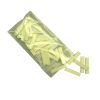YSI 6131 Blue-Green Algae Sensor
The YSI 6131 blue-green algae sensor monitors algal populations at natural levels in freshwater, providing an early warning for bloom conditions.
Features
- YSI 6131 BGA Sensor is designed for freshwater (phycocyanin) environments
- Optimized for excellent sensitivity for monitoring algal populations at natural levels
- Insensitive to potential interferences including chlorophyll, turbidity, and dissolved organics
- Expedited repair and warranty service
- Lifetime technical support
- More
Overview
The YSI 6131 blue-green algae sensor monitors algal populations at natural levels in freshwater, providing an early warning for bloom conditions. Blue-green algae (or cyanobacteria) monitoring is of growing interest due to the problems some species can present through the production of toxins and compounds that deteriorate the quality of drinking water and through the formation of blooms. Blue-green algae are of interest for ecosystem studies and monitoring as well, where they may represent the most abundant primary producer.
Compatible with YSI 6-Series Sondes
The YSI 6131 blue-green algae sensor is fully compatible with all YSI 6-series sondes equipped with optical ports. YSI's optical sensors use an integrated wiping system to provide anti-fouling in the most hostile environments. Durable mechanical features include a non-corroding titanium wiper shaft, a replaceable wiper shaft seal, and a new switch-controlled wiper parking system to prevent mis-parking.
- Range: ~0 to 280,000 cells/mL; 0 to 100 RFU
- Detection Limit: ~220 cells/mL
- Resolution: 1 cell/mL; 0.1 RFU
- Linearity: R2> 0.9999
- Warranty: 2 years
In The News
Save our Bogs! Culture, Conservation and Climate Action in Ireland’s Peatlands
Characterized by long-term accumulation under waterlogged conditions, peatlands exist on every continent and account for 3-4% of the global land surface . Small but mighty, these often overlooked wetland environments are estimated to hold as much as one-third of the world's organic carbon in their soil—twice the amount found in the entirety of the Earth's forest biomass. While healthy peatlands can trap and store carbon, regulate water, and provide important habitats for rare species, human alteration has disturbed peatland carbon and nitrogen cycles on a global scale. Approximately 12% of the world’s peatlands have been drained and degraded through conversion for agriculture, forestry, infrastructure development, and other uses.
Read MoreSargassum Surge: How Seaweed is Transforming our Oceans and Coastal Ecosystems
Until recently, Sargassum –a free-floating seaweed–was distributed throughout the Sargasso Sea , the north Caribbean Sea, and the Gulf of Mexico. But in the space of a decade, this seaweed has, as one scientist remarks , “Gone from a nonfactor to the source of a terrible crisis.” Driven by climate change, anomalous North Atlantic Oscillation in 2009-2010 and a glut of anthropogenic pollutants, sargassum has proliferated. Seasonally recurrent mats as deep as 7m now bloom in the “Great Atlantic Sargassum Belt” (GASB), which covers areas of the Atlantic from West Africa to the Caribbean Sea and Gulf of Mexico. Every year, millions of tons wash up along the shores of more than 30 countries . Dr.
Read MoreGreat Lakes Research Center: Designing Targeted Monitoring Solutions
According to the National Oceanic and Atmospheric Administration ( NOAA ), the Great Lakes have more miles of coastline than the contiguous Atlantic and Pacific coasts combined and contain 20 percent of the world's freshwater, making it a critical region to protect and conserve. Continuous monitoring and data-informed resource management are key components of managing waters in the region. Hayden Henderson, a research engineer with the Great Lakes Research Center (GLRC), designs and deploys monitoring platforms throughout the Great Lakes. With a background in environmental engineering, Henderson enjoyed the challenge of creating systems and making them work to obtain difficult, remote measurements.
Read More












